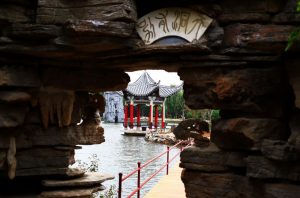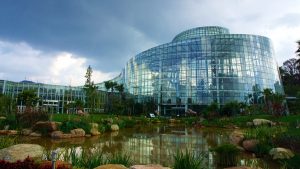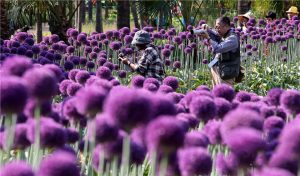
Kunming Botanical Garden

Chinese Name: 昆明植物园
Chinese Pinyin: Kun Ming Zhi Wu Yuan
English Name: Kunming Botanical Garden
Type: Garden, Natural Landscape
Admission Fee: 10 yuan/person for West Garden, 5 yuan/person for East Garden
Opening Time: 9:00-17:00
Reccommended Visiting Time: 1-2 hours
Location: No.132, Lanhei Road of Panlong District in Kunming
Overview of Kunming Botanical Garden
Kunming Botanical Garden (KBG) was established in 1938. It is affiliated to the Kunming Institute of Botany under the Chinese Academy of Sciences. It has an area of 44 hectares. The Garden is a comprehensive institution with the main task of ex-situ conserving and sustainably utilising the rare and endangered plants, endemic taxa, and economically important plant species in the Hengduan Mountains and in the Yunnan Plateau. The Camellia Garden is one the oldest and most important specialized gardens within KBG.
In the wider KBG landscape we have 13 other specialised gardens which include: YUESAI Rhododendron Garden, Rock Garden, Monocotyledons, Medicinal Herbs, Magnolias, Arboretum, Gymnosperm Plants, Ornamental Fruits and Foliage, Endangered Plants Section, Sweetgum Avenue, Glasshouses, Rosaceae Section and the Begonia Collection. You could see many “3E” plants (Endemic, Endangered and of Economic Importance) in KBG. The Sweetgum Avenue is the main attraction in the Autumn.
Camellias of Kunming Botanical Garden (Highlights)

Around 8000 individuals of 1025 taxa (78 species and 1000 cultivars) in the genus Camellia are now displayed in KBG. The species C.reticulata is the city flower of Kunming. The most important scenic area is the beautiful forest of 800 trees of C.reticulata many of which are more than 70 years old in this large area. These plants are in full bloom during the Chinese New Year and this ensures that the Camellia Garden is a colourful and exciting place for celebrating this special holiday. The golden camellia collection is another important feature in KBG which has 30 species with yellow flowers. The Camellia garden has several collections with special theme: the Reticulata Zone,the Japonica Zone, the Sasanqua Zone, the Wild Species Zone, Camellia Greenhouse and the International Camellia Garden of Friendship set up in 1984, where camellias were planted by some 40 members of the ICS in four areas: Asia, Europe, N. America and Australasia.
Main Attractions in Kunming Botanical Garden
The park is divided into two parks: East and West. It has been built into Mountain and Tea Garden, Rock Garden, Bamboo Garden, Yuxi Rhododendron Garden, Leaf View Orchard, Baicao Garden, Magnolia Garden, witch hazel orchard, very small population plant orchard, gymnosperms and other 15 special types of gardens (regions).
Theme Gardens of Kunming Botanical Garden
1. Camellia Garden: It covers 150 Mu (Chinese acres), it has been planted with more than 15,000 camellia trees of 200 kinds, including Camellia reticulate, Camellia japonica, Camellia sasanqua, and Camellia nitidissima, etc.
2. Azalea Garden: There are nearly 10,000 azalea trees of 100 kinds including Rhododendron simsii, Rhododendron delavayi, and Rhododendron irroratum Franch, etc.
3. Greenhouse Area Greenhouse Area: It includes halls of Orchids, Foliage plants, Begonia, Tropical Plants, Palm tree, Cactus, and Succulent plants, etc.
4. Arbor Trees Area Arbor Area: It includes Magnolia Garden, Rosaceae Garden, and Bamboo Garden etc. rare plants inside are delavay magnolia, michelia chartacea, Manglietia insgnis, and Magnolia campbellii, etc.
5. Ferns Garden: Ferns Garden covers 50 Mu. There are nearly 400 kinds of ferns planted with it including tree fern, brake fern, Cheilosoria hancockii (lip fern), adiantum, Coniogramme intermedia, Allantodia megaphylla, Cyclosorus interruptus, and Asplenium ensiforme (sword-leaved spleenwort), etc.
Cultural Activity
Popular Science Activities: Planning and holding “Small Microfamily of the Botanical World” of High School Science Camp, “Finding Plant Baby” of Parent-child Science Popularization activities, “Re-understanding Botanical Gardens”, “where to go in summer” and “Botanical Garden at Night” and other special theme science popularization activities have been more than 50 times
Value of Kunming Botanical Garden
Scientific Research Value

Kunming Botanical Garden is mainly concerned with the introduction and conservation of rare and endangered plants, endemic groups and important economic plants in Yunnan Plateau and the southern tip of Hengduan Mountain, and the introduction and domestication of resource plants and the protection of germplasm resources.
Since the establishment of the park, it has received more than 40 awards at the provincial and ministerial levels, published more than 600 papers, more than 50 patents authorized to invent, registered more than 100 new plant varieties, and published more than 60 monographs.
Educational Value
Since 2012, Kunming Botanical Garden has successfully undertaken four training courses on Garden Horticulture and Landscape Construction of the Chinese Botanical Garden Association. A total of 100 students from 40 botanical gardens and related units in the country have been trained in advanced garden gardening, and 12 excellent students have been sent to the Royal Botanical Garden in Edinburgh for further study and improvement.
The Honors of Kunming Botanical Garden
The Kunming Botanical Garden has been named “National Science Popularization Education Base”, “Yunnan Province Science Popularization Education Base”, “National Youth entering the Science and Technology World demonstration Base”, “National Youth Science and Technology Education Base”, Kunming Science Popularization Base, etc., Mountain Tea Garden won the title of “International Outstanding Tea Garden”. [1] won the excellent national science popularization education base of 2016. Awarded the “2011 Kunming City Science Popularization Base” title.

Related Institute
Kunming Institute of Botany (昆明植物研究所)
Kunming Institute of Botany is a research institution in the field of Botany, which is located in Kunming. The Institute is one of the major herbariums in China and maintains a collection of over 1,000,000 specimens of plant. There are also over 200,000 specimens of fungi, lichens, and mosses, many of which were donated by mycologist Mu Zang.
The Institute also has a botanical garden. Currently there are around 5,000 species of vascular plants in the botanical garden. There are several sections, with specific collections, such as: Arboretum, Collection of herbs, Endangered species and rare species, Aquatic species, Gardens of specimens of the genus Camellia, Magnolia, and Begonia, Ferns.
All the plants that are hosted in the botanical garden are a foundation on which to work, for the research and experience of the staff of scientists at the Institute. Studies are conducted to improve the cultivation of plants of economic interest, with a view to better use, both nutritionally and industrially. Currently a digital database of the botanical garden is being prepared, as well as of wild plants in the province of Yunnan.
How to Get there?
By Bus
1.Take bus No. 9, 79, 128, 159, 249 directly to north gate station of Kunming botanical garden or Heilongjiang Pool station about 8 minutes walk to east garden of botanical garden.
2.Take bus No. 115 to Ciba Terminal, then walk about 15 minutes to the north gate of Kunming Botanical Garden.
Self-driving
Drive from the center of Kunming city along Longquan road for about 30 minutes to the north gate of Kunming Botanical Garden.
Travel Tips
1. Disabled persons, people over 70 years old (including) and children below 1.2 meters in height are free of charge; 2. Retired cadres can go with one person free of charge;
3. Active serviceman, 60-69 years old and the student group may purchase the discount ticket to enter the park;
4. Group visitors buy a full fare of 16 free 1.

 7 Days GolfingTour
7 Days GolfingTour
 8 Days Group Tour
8 Days Group Tour
 8 Days Yunnan Tour
8 Days Yunnan Tour
 7 Days Shangri La Hiking
7 Days Shangri La Hiking
 11 Days Yunnan Tour
11 Days Yunnan Tour
 6 Days Yuanyang Terraces
6 Days Yuanyang Terraces
 11 Days Yunnan Tour
11 Days Yunnan Tour
 8 Days South Yunnan
8 Days South Yunnan
 7 Days Tea Tour
7 Days Tea Tour
 8 Days Muslim Tour
8 Days Muslim Tour
 12 Days Self-Driving
12 Days Self-Driving
 4 Days Haba Climbing
4 Days Haba Climbing
 Tiger Leaping Gorge
Tiger Leaping Gorge
 Stone Forest
Stone Forest
 Yunnan-Tibet
Yunnan-Tibet
 Hani Rice Terraces
Hani Rice Terraces
 Kunming
Kunming
 Lijiang
Lijiang
 Shangri-la
Shangri-la
 Dali
Dali
 XishuangBanna
XishuangBanna
 Honghe
Honghe
 Kunming
Kunming
 Lijiang
Lijiang
 Shangri-la
Shangri-la
 Yuanyang Rice Terraces
Yuanyang Rice Terraces
 Nujiang
Nujiang
 XishuangBanna
XishuangBanna
 Spring City Golf
Spring City Golf
 Snow Mountain Golf
Snow Mountain Golf
 Stone Mountain Golf
Stone Mountain Golf














